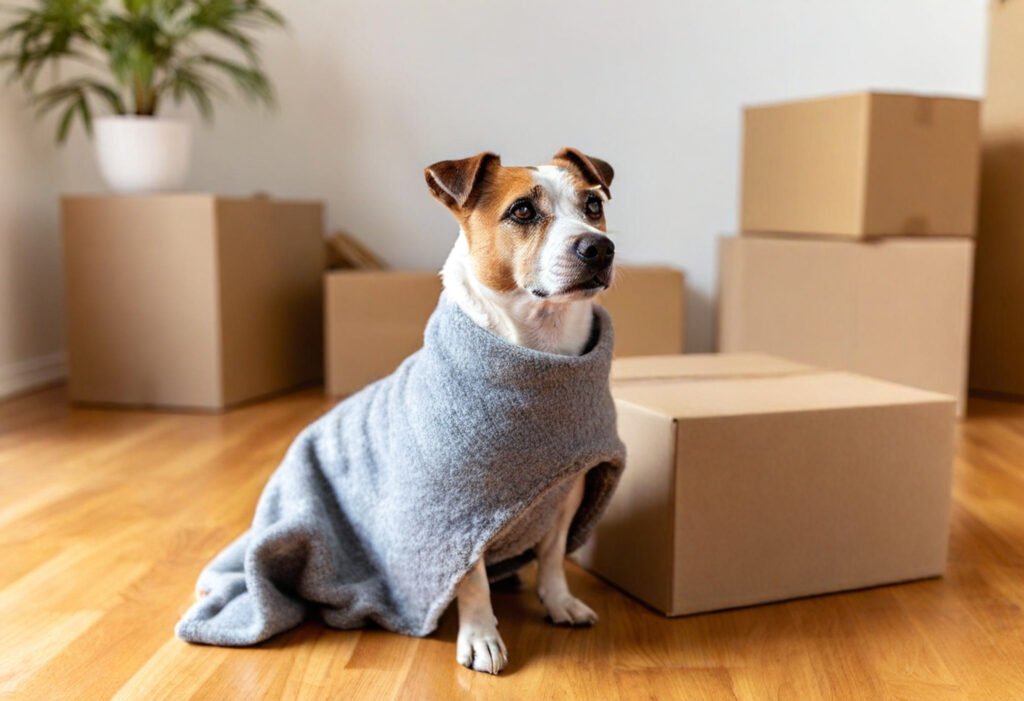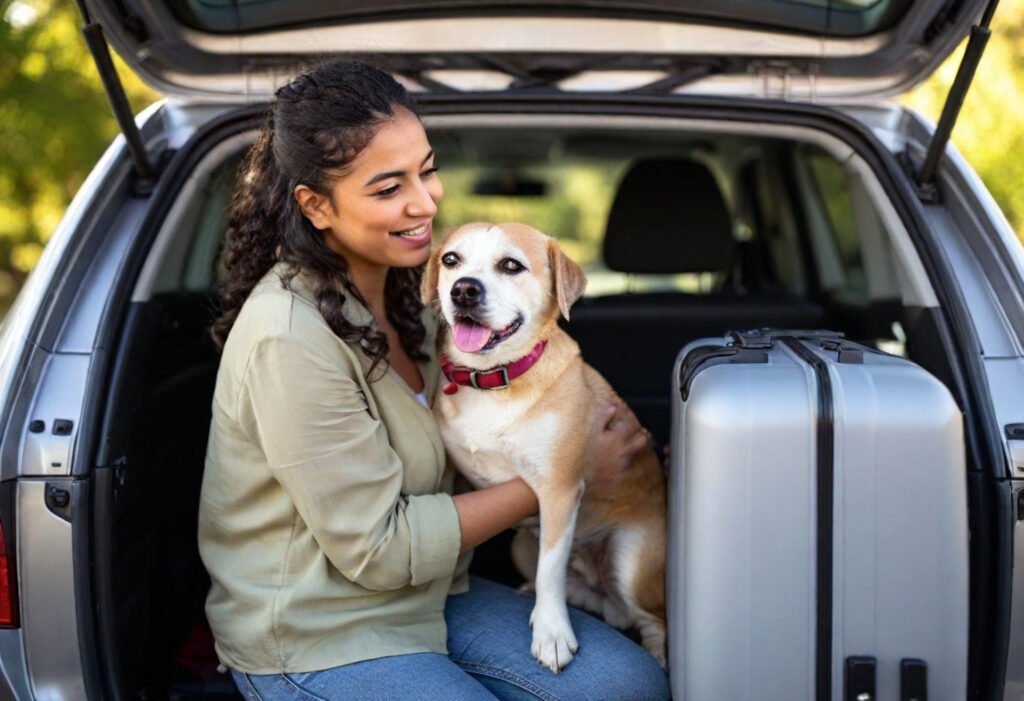People often underestimate the impact of moving on their dogs. Our four-legged friends can become anxious during relocations because they encounter unfamiliar sights, smells, and sounds in their new environment. On top of that, it gets worse because dogs can sense their owners’ emotions and pick up on our stress related to moving.
Moving creates substantial stress for dogs. The stress levels can rise so much that your dog’s health might suffer. The good news is that several proven strategies can help your canine companion transition smoothly to a new home. You can prepare your dog months ahead with vet visits and stick to familiar routines even during the chaos. These approaches will reduce your pet’s anxiety. We’ll show you everything to protect your dog’s wellbeing before, during, and after your move.
Prepare Your Dog Before the Move
Your dog’s moving stress reduces with proper preparation. Starting the process a month before moving gives your furry friend enough time to adjust without feeling overwhelmed by sudden changes.
Visit the vet for a health check
Book a veterinary appointment right when you decide to move. Your vet provides valuable advice based on your dog’s temperament and health needs. The visit ensures all vaccinations stay current and helps you get a health certificate, which you might need for moving across state lines. Natural calming remedies work better than sedatives since sedatives can affect your dog’s body temperature regulation.
Update ID tags and microchip info
Dogs face a higher risk of getting lost on moving day, so updated identification becomes vital. Your dog’s ID tags should show your current phone number and new address. The microchip registration needs immediate updating after the move. A microchip becomes useless without current contact details. Adding an emergency contact helps when you’re unreachable.
Get your dog used to the travel crate
A crate becomes your dog’s safe space during moves. Start getting them comfortable at least three weeks before moving day. Place the crate in a familiar spot with an open door so your dog can explore freely. Feed meals inside to build positive connections. Close the door during meals after a week and slowly extend the time inside. The crate should never punish your dog, as this creates bad memories.
Pack a dog-specific travel bag
A separate bag helps organize everything your dog needs during the move and first few days in your new home. Pack these items:
- Food, water, and bowls
- Medications and first-aid supplies
- Comfort items (favorite toys and blankets)
- Leash, harness, and updated ID tags
- Copies of medical records
- List of emergency vets in your new location
These steps create a smoother transition for you and your dog when planned well.
Keep Your Dog Safe and Calm on Moving Day

“Dogs pick up on anxiety easily, and tend to duplicate it. A dog’s mood parallels their owner’s mood.” — Laura McHolm, Co-Founder of NorthStar Moving Company, pet relocation expert
Moving day brings the biggest challenge for your furry friend. The commotion of movers, shuffling boxes, and strange noises can trigger intense anxiety in even the most relaxed dogs. Let me show you how to reduce your dog’s stress during this chaotic day.
Create a quiet space away from the chaos
Your first task is to set up a “safe zone” in one room of your home where your dog can retreat. Set up this area with your dog’s bed, toys, food, water, and maybe a piece of your clothing that has your scent. Make sure to put a sign on the door so movers don’t open it by accident. Your pet needs a well-ventilated and temperature-controlled space to stay comfortable while the activity continues in other areas.
Use calming aids or pheromone sprays
These products can help reduce your dog’s anxiety on moving day:
- Pheromone products like Adaptil diffusers or sprays mimic a mother dog’s calming pheromones that soothe puppies
- Pressure vests such as ThunderShirts give gentle, constant pressure that feels like a comforting hug
- Calming treats made with natural ingredients help promote relaxation
Start using these aids a few days before the move to see how they work, though pheromone sprays need about 15 minutes for their alcohol smell to fade.
Ask a friend or pet sitter for help
The smartest way to move with pets is to arrange for your dog to stay somewhere else. You could:
- Have a trusted friend watch your dog
- Book a day at a professional pet sitter’s home
- Reserve a spot at a doggy daycare
This keeps your pet away from the stress of moving and ensures they get proper attention and exercise.
Avoid last-minute changes to routine
Your dog’s regular schedule plays a vital role. Dogs need consistency, especially with:
- Feeding times
- Walking schedules
- Play sessions
Familiar routines give your dog security during changes. No matter how busy you are, make time for these activities—they help your dog adjust to the transition and prevent stress-related behavior problems.
Help Your Dog Adjust to the New Home
“Highly territorial animals, dogs can find the experience of moving to a new home difficult and occasionally distressing.” — Allied Moving Services, International moving and relocation company with expertise in pet relocation
The real work of reducing moving stress on dogs starts right after you reach your new home. Your dog’s adjustment and mental well-being depend heavily on the first few weeks in their new environment.
Set up a familiar space with their bed and toys
Your dog needs familiarity to adapt successfully. Create a dedicated space right away with your dog’s unwashed bed, toys, and other belongings. Don’t clean these items – their familiar scent offers comfort in the new surroundings. This designated area gives your dog a safe retreat when the new sights and sounds become overwhelming. Most dogs like staying close to their humans, so pick a quiet corner where family activities happen.
Stick to feeding and walking schedules
The answer to moving is stressful for dogs lies in maintaining consistency. Dogs need predictable routines during major life changes. Keep the same feeding times, walk schedule, and play sessions you had before the move. This stability helps prevent digestive issues that often happen during transitions. Bring water from your old home and mix in new water gradually over several days.
Let them explore one room at a time
A whole new house can overwhelm your dog at once. Start with a room-by-room approach, keeping them on leash at first. Your dog can process new scents and spaces without feeling threatened this way. Watch their body language – don’t push them to explore if they seem hesitant.
Watch for signs of stress or anxiety
Does moving stressed dogs out enough to change their behavior? Yes. Look for signs like excessive panting, pacing, lip licking, poor appetite, or unusual bathroom habits. Talk to your veterinarian if these signs last more than a few days. Most dogs need at least two weeks to decompress, but complete adjustment might take several months.
Secure the New Environment for Your Dog

Your dog’s safety in the new environment marks a crucial final step in handling moving stress on dogs. A settled-looking dog might still feel anxious in unfamiliar surroundings and try to escape when you least expect it.
Check the yard for escape routes
Take a walk around your yard’s entire perimeter to spot any security weak spots. Dogs escape in different ways – some jump over fences, others climb using objects nearby, while the determined ones dig their way under. You should remove woodpiles, garbage cans, or playground equipment near fences that dogs could use as climbing aids. A chicken wire buried along the fence line or a concrete-filled trench can stop your digger from escaping. Make sure all gate latches work well and add locks or hook-and-eye closures if needed.
Clean the home to remove old pet scents
Old pet smells can make your dog uneasy. They might feel like they’re in someone else’s territory. Pet-safe cleaning products work best throughout the house – vinegar gives you a non-toxic option instead of chemicals. Areas where previous pets had accidents need extra attention. Your new home should be pet-proof with secured electrical cords, cabinet locks, and blocked small spaces where dogs might get stuck. Even natural cleaners can harm your pet if they drink them, so keep all supplies locked away.
Introduce your dog to the neighborhood slowly
New sensory experiences take time for dogs to process. Begin with brief, controlled walks and expand your route as your dog feels more at ease. Until they adjust fully, keep them on a leash since familiar scents and landmarks might have changed. Let them meet neighbors at their own pace. Watch how they react during these meetings – heavy panting, tucked tail, or walking resistance shows stress. Make the backyard a safe space rather than just an enclosed area. Spend quality time there together to build happy memories.
Conclusion
Moving with your furry companion doesn’t have to be overwhelming for either of you. This piece explored proven ways to reduce anxiety during this big life change. Your dog depends on you for security during transitions. Your preparation makes all the difference in how well they adjust.
Dogs feel stress during moves, but show amazing resilience with proper support. Good preparation helps create a soaring win, from early vet visits to microchip updates and step-by-step crate training. A quiet space away from moving day chaos helps your dog feel safe and protected.
Your dog needs consistency above all else. Familiar items, regular routines, and careful introduction to new spaces help keep them emotionally stable. These strategies work like building blocks to boost your dog’s confidence in new surroundings.
Each dog adjusts differently, so patience becomes your best friend. Some pets may feel at home within days, while others need weeks or months to settle fully. Stress signs usually fade as your dog builds positive connections with your home.
Note that your calm attitude affects your dog’s response to change a lot. Dogs can read our emotions with amazing accuracy. Your confidence and routine tell them everything will be fine. Your new chapter together starts with understanding, preparation, and patience – three elements that create the foundation for a happy dog in your new home.

